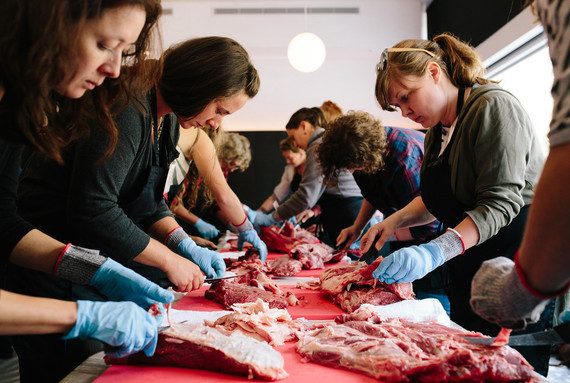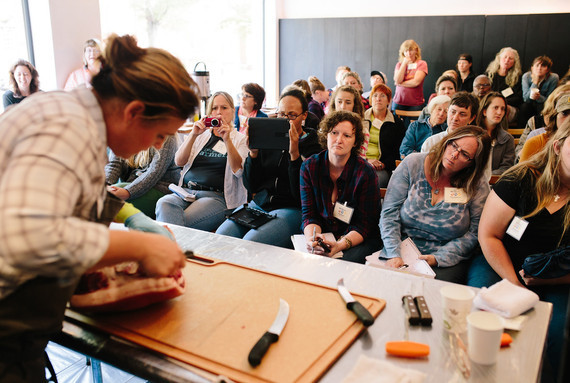
Co-authored by: Nancy Creamer, Co-Director of the Center for Environmental Farming Systems (CEFS) and Sarah Blacklin, Director of CEFS’ NC Choices initiative
This blog post originally appeared in The Huffington Post.
There are many reasons why most people have trouble drawing a connection between the meat they purchase in a grocery store and the animal that it comes from. Most people’s experience buying meat involves perusing a grocery aisle stocked with a handful of the nation’s most popular cuts, uniformly packaged and wrapped in plastic on a foam tray.
While there’s increased interest nationally in local pastured meat, peoples’ purchasing habits and tastes have been conditioned by our industrial food system over the past 50 years to just a handful of cuts. So what happens to the rest of it?
All the parts of the animal that don’t conform to popular food tastes are sold to rendering companies and converted into an assortment of other products from soaps to Jell-O to dog food. Large commercial processors actually make a significant amount of money from selling their “waste” to rendering companies. A few companies own the animals and the processing, enabling them to turn large volumes of this “waste” into profit streams. Large commodity systems are incredibly efficient in their use of the whole animal because of economies of scale.
However, this is not the case for local meat. The local meat market has exploded in recent years with consumers wanting to know who their farmer is, how the meat is produced, and under what conditions. In North Carolina, the number of farmers selling local, pastured meat direct to consumer has gone from 1 in 2002, to more than 1000 now (NCDA MPID, meat and poultry handlers). Although the demand is on the rise, the local meat system is still small-scale and inherently less efficient since it depends on sustaining many small independent businesses from the farmer to the processor.
Many rendering companies actually charge small processors for having to pick up their unused parts due to low volume. For those small processors who are paid, it’s pennies on the dollar as compared to big commercial plants. In a few cases, small plants aren’t large enough to even be serviced by rendering companies and to the dismay of both the farmer and the processor, all that valuable by-product goes into the landfill. In order for small scale local meat production to grow profitably in the marketplace, the local food system needs to develop ways to better coordinate waste pick up from small processors. In the meantime, a new movement is encouraging consumers to do their part in reducing animal waste in the local meat supply chain.
Women food system leaders are among those working to develop a coordinated supply chain and to broaden the consumer palate in favor of new cuts as one way to reduce waste. At the recent Women Working in the Meat Business Conference, organized by NC Choices, a Center for Environmental Farming Systems Initiative, topics such as How Much Money Am I Putting in the Grinder covered strategies to explore new cuts in the animal that can marketed to consumers to reduce waste. Women in Meat graduate and farmer, Tootie Jones, states,
By teaching how to extract high value cuts from the animal, I was made closely aware of how much money I was grinding into a lower dollar product … My meat sales have increased over 47% this year.
Leaders such as Andrea Reusing, James Beard award-winning chef of Lantern Restaurant and The Durham, are making tremendous strides in reducing waste through taste. For Reusing, women are central to this movement:
Women can see food a bit differently than men, especially when it comes to animals. They tend to take a longer view; thinking about the life of the animal as more than just a means to an end. That translates into more money to the farmers and creating value where there is none.
Reusing is changing consumers’ acceptance and exposure toward whole animal dining by making lesser known cuts, value-added items and gutsier flavors more mainstream.
So, how much waste are we really talking about? In the case of just one east coast poultry processing plant that services over 300 local farmers and individuals annually, they throw away approximately 85 tons of animal by-product to the landfill a year. That’s approximately 15 elephants’ worth of waste – and all because their volume is too small to be serviced by a rendering company. For local beef, farmers typically sell approximately 380 lbs. of retail cuts off a 1,100 lb. steer, meaning approximately 65% of the animal might go to a rendering plant or in some cases to the landfill.
While regulations limit some of what we can get back from our processors, eating less common cuts and buying more whole animals can benefit both the farmer and the consumer, while reducing waste. Farmers can turn a profit more quickly selling one whole animal to a customer rather than over 30 pieces of meat to 30 customers by the piece. For the consumer, buying larger bundles or whole animal usually translates to cost savings, more meat on the table, and less waste.
For example, if more consumers switched from purchasing retail cuts to whole animal, they could take home more meat, more flavorful fat for cooking, more bones for stock while simultaneously, reducing waste from that animal by 25%! On the statewide level that could equate to 250,000 lbs. of meat going home to consumers rather than going through a waste process, just by changing our purchasing habits (data based on CEFS statewide local meat survey).
For those who aren’t ready to buy a whole animal, consider supporting local butcher shops and restaurants that are buying whole animals from local farms, experiment with cooking new meat cuts at home, or sign up for a meat CSAs at a local farmers market as one way to try new meats and help the local food economy grow.
Find this article on The Huffington Post.
Photos by Briana Brough Photography


